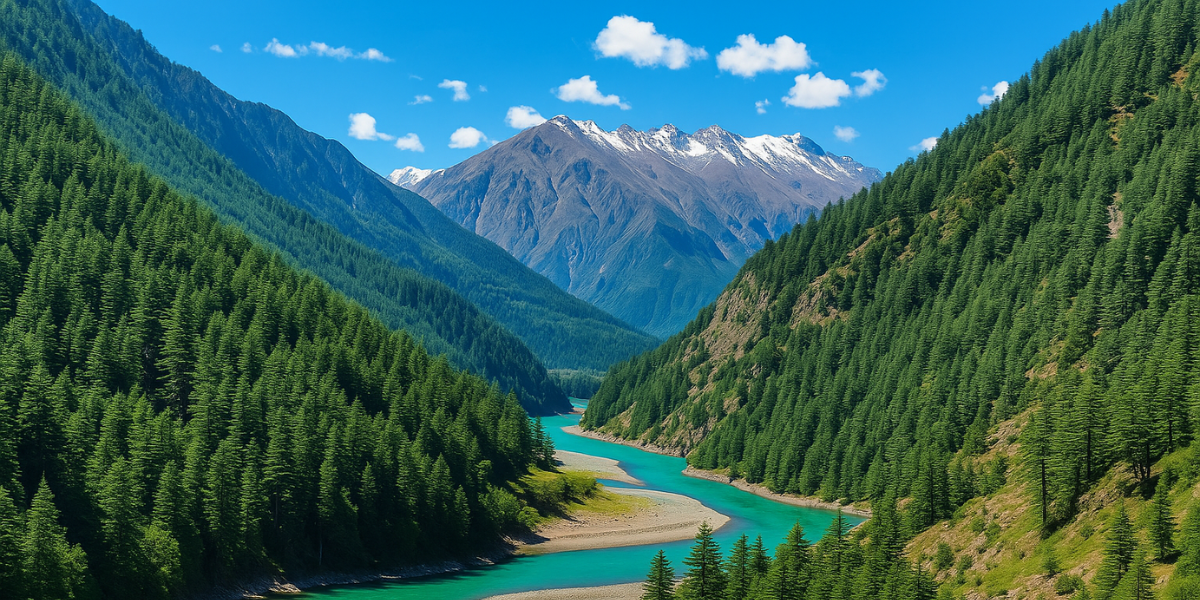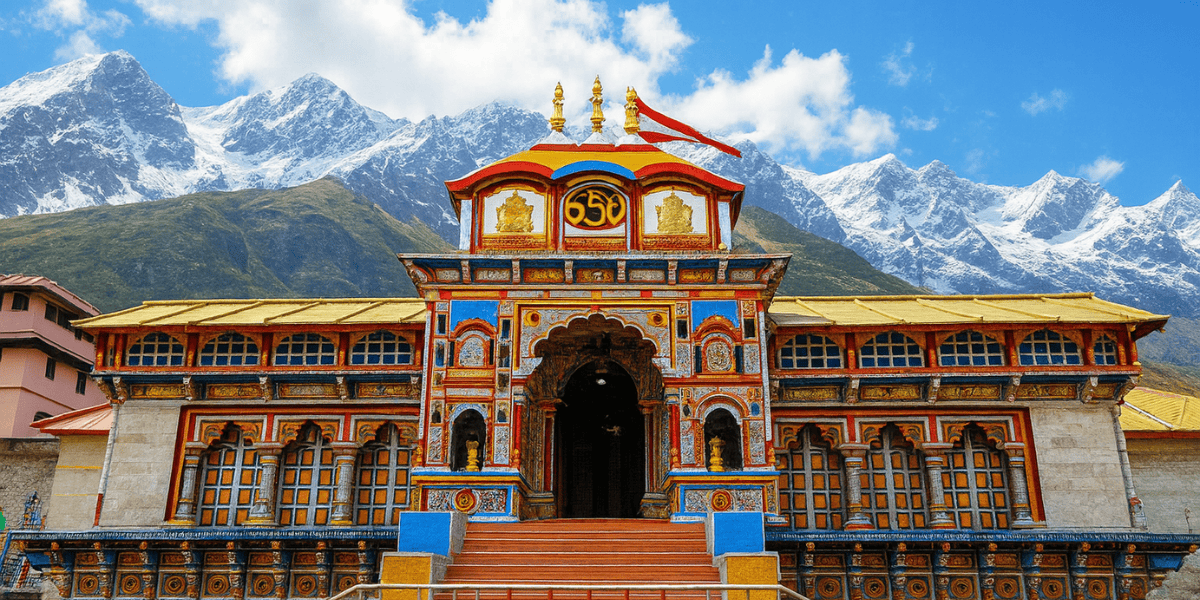Harsil Valley is a peaceful Himalayan retreat in Uttarkashi, about 75 km from Gangotri and 230 km from Dehradun. Set at an altitude of 2,620 meters, it sits along the Bhagirathi River and is famous for its apple orchards, pine forests, and scenic beauty. Harsil Valley is ideal for slow travel, nature lovers, and pilgrims en route to Gangotri Dham. Nearby villages like Mukhba (1 km) and Dharali (2 km) add cultural charm. Best visited between April–June and September–November.
Table of Contents
Harsil Valley
Harsil Valley is a peaceful mountain destination in Uttarkashi, located along the Bhagirathi River. It’s surrounded by tall pine trees, apple orchards, and snow-covered Himalayan peaks. Many travelers use Harsil as a stopover on the way to Gangotri, but it’s a destination worth staying in for 2–3 nights. The village is quiet, clean, and perfect for people looking to relax in nature. There’s no rush, no noise, and no crowd. You can go for walks, sit by the river, enjoy fresh apples (in season), and interact with the local villagers. It’s ideal for senior citizens, couples, solo travelers, and photographers.
- Altitude: 2,620 meters approx.
- Nearest town: Uttarkashi (75 km)
- Type of place: Non-commercial, peaceful, scenic
- Ideal stay: 2–3 days
- Popular for: Apple orchards, river views, and silence
Harsil Uttarakhand
Harsil is a small village in the Garhwal Himalayas of Uttarakhand, located on the road to Gangotri. It lies about 470 km from Delhi and is part of the Char Dham travel circuit. Unlike busy hill stations, Harsil remains natural and quiet. You won’t find markets, crowds, or hotels with loud music here. Instead, you’ll see wooden houses, army camps, and thick forests. The local people are warm and welcoming. The air is clean, and the river flows calmly through the village. Harsil is not for people looking for luxury but perfect for anyone wanting a real mountain experience.
- Region: Uttarkashi district
- Distance from Delhi: Around 470 km
- Known for: Peaceful environment, local culture
- Closest town: Uttarkashi (about 2–3 hrs drive)
- Road condition: Narrow but scenic
Harsil Village
Harsil village is the heart of the valley and offers a true Himalayan experience. The wooden homes, quiet lanes, and clean surroundings make it a favorite for people who like simple mountain life. Local villagers belong to the Jadh tribe and follow old customs. They grow apples, rear sheep, and live a peaceful life. The Bhagirathi River flows right beside the village. You can walk around, visit small temples, or simply sit and enjoy the view.
- Community: Mostly Jadh tribe families
- Popular sights: Apple farms, small temples, riverside areas
- Lifestyle: Simple, traditional, slow-paced
- Activities: Walking, photography, local food tasting
- Tip: Talk to locals for real travel stories
Where is Harsil Valley Located?
Harsil Valley is located in Uttarkashi district, around 450 km from Delhi (12-13 hours by road) and approximately 245 km from Haridwar (7-8 hours), accessible via National Highway 108. Harsil serves as a peaceful village with Bhagirathi River flowing through.
Location: Uttarkashi district in the state of Uttarakhand.
Distance from Haridwar: 244 Kilometers
Distance from New Delhi: 450 Kilometers
Distance from Gangotri: 26 Kilometers
How to Reach Harsil Valley?
Harsil Valley is 450 km from Delhi (12-13 hours), 244 km from Haridwar (7-8 hours), completely accessible by road. While air and rail options are available nearby, the final leg to Harsil must be completed by road.
- By Road: Harsil is 450 km from Delhi (12-13 hours), 244 km from Haridwar (7-8 hours), and 200 km from Dehradun (6-7 hours), with regular buses and taxis available.
- By Air: The nearest airport is Jolly Grant Airport in Dehradun, located about 245 km from Harsil.
- By Train: The closest railway station is Rishikesh, approximately 244 km from Harsil. From both the airport and railway station, taxis or buses can take you to Harsil.
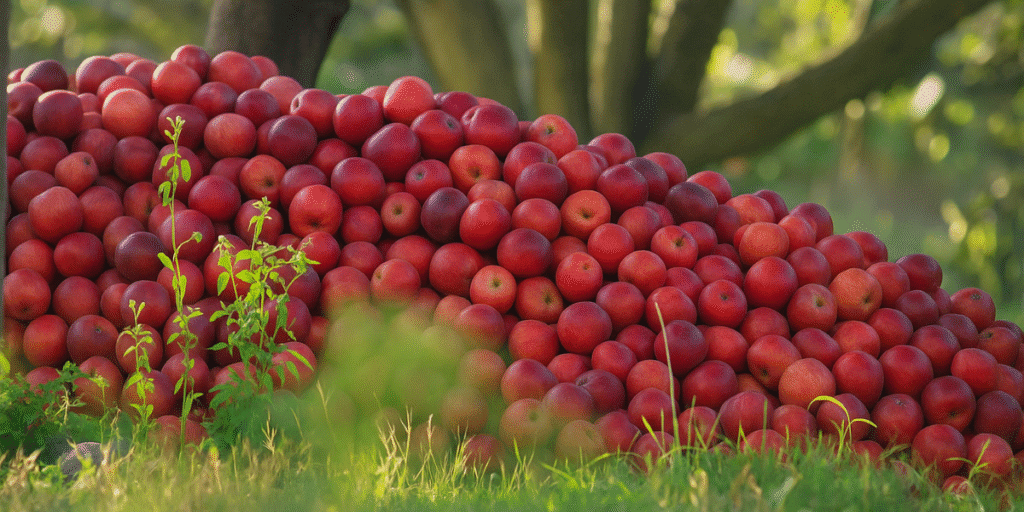
What is Harsil Valley Famous For?
Harsil Valley is famous for its apple orchards, introduced by British settler Fredric E. Wilson. It was also the shooting location for iconic filmmaker Raj Kapoor’s blockbuster Ram Teri Ganga Maili. Additionally, the nearby Nelong Valley, sharing borders with Tibet, is another popular tourist spot, offering stunning landscapes and a unique, off-the-beaten-path experience.
- Home to picturesque apple orchards.
- A filming location for iconic movies like Ram Teri Ganga Maili.
- Gateway to Gangotri Temple and other spiritual sites.
History of Harsil’s Apple Orchards
Ancient Trade Route: Harsil lies on the old caravan trail between India and Tibet, facilitating trade in commodities such as wool, salt, and spices. This exchange fostered a unique blend of cultural influences in the region.
Garhwal Kingdom: Historically, Harsil was part of the Garhwal Kingdom. After the Anglo-Nepal War in 1815, the British Raj, allied with the Garhwal Kingdom, took control of the eastern half of Garhwal. This period marked the beginning of British influence in the valley.
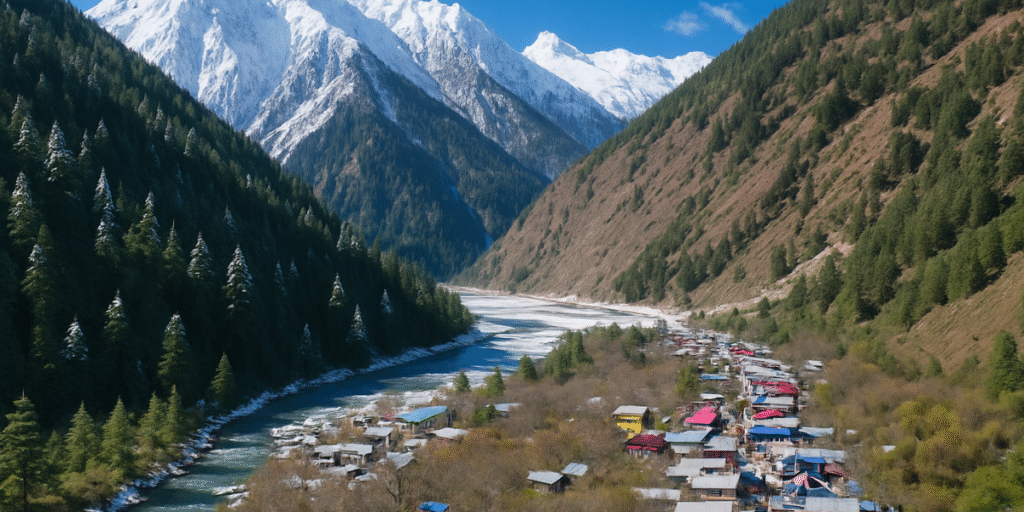
Harsil Weather
Harsil’s weather generally stays cold and fresh throughout the year. Even during summer, you won’t need a fan. In May and June, days are sunny but not hot, and nights are chilly. Autumn is cool and dry, perfect for sightseeing and photography. Winter is very cold and snowy, with temperatures going below zero. Monsoon months (July–August) are risky due to landslides. Always check road conditions before traveling in rainy season. The best time to enjoy Harsil’s beauty is during late spring or post-monsoon autumn.
- Summer (May–June): 10°C to 20°C
- Autumn (Sept–Oct): 5°C to 15°C
- Winter (Dec–Feb): -5°C to 5°C
- Avoid: Rainy season (July–August)
- Tip: Carry woolens in all seasons
Harsil Temperature
Harsil’s temperature stay’s low throughout the year. In summer, you can expect daytime temps around 15–20°C, but nights fall to 5–10°C. It’s best to carry jackets even in May. In October, the air turns cold and sharp, especially after sunset. Winters are harsh and snowy, with temperatures dropping below -5°C. Many roads get blocked after heavy snowfall, so winter travel requires planning. If you’re not used to mountain air, rest for a few hours after arrival. Keep your body warm and stay hydrated.
- Summer days: 15–20°C
- Summer nights: 5–10°C
- Winter lows: -5°C or below
- Coldest months: December–January
- Tip: Dress in layers, wear thermals
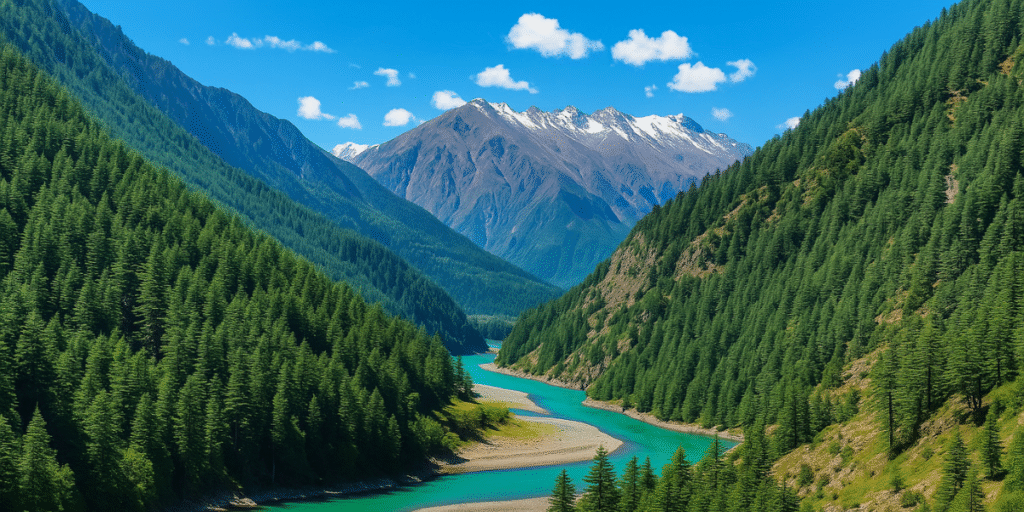
What is the Best Time to Visit Harsil Valley?
Best time to visit Harsil Valley is from April to June (summers) and September to November (post monsoon). During summer’s the weather is pleasant, mostly clear, cool, with great views and best for road travel, However post-monsoon is great if you want to see apple orchards and greenery. Monsoon months (July–August) can be tricky due to road blocks due to rains. Winter (Dec–Feb) brings snow—beautiful but not ideal for everyone, as roads may close. If you like quiet and cold, winter works too.
Winter in Harsil Valley
- Temperatures drop to 0°C at night and hover around 10°C during the day.
- Heavy snowfall in January and February may cause road closures.
- Snowfall is at its peak in early February and starts melting by March.
Summer in Harsil Valley
- The valley comes alive with tourists enjoying the pleasant weather and stunning natural beauty.
- May and June are the busiest months, with daytime temperatures around 20°C and nights at a cool 10°C.
Harsil Valley Weather Throughout the Year
Harsil Valley offers a unique experience in every season. The weather here is perfect for various activities, from summer hikes to winter snow adventures.
- Summer (April–June): Pleasant weather ideal for trekking and sightseeing.
- Monsoon (July–September): Lush greenery and refreshing ambiance, though prone to landslides.
- Autumn (October): Crisp air and vibrant foliage, a favorite for photographers.
- Winter (November–March): Snow-covered landscapes perfect for skiing and snow treks.
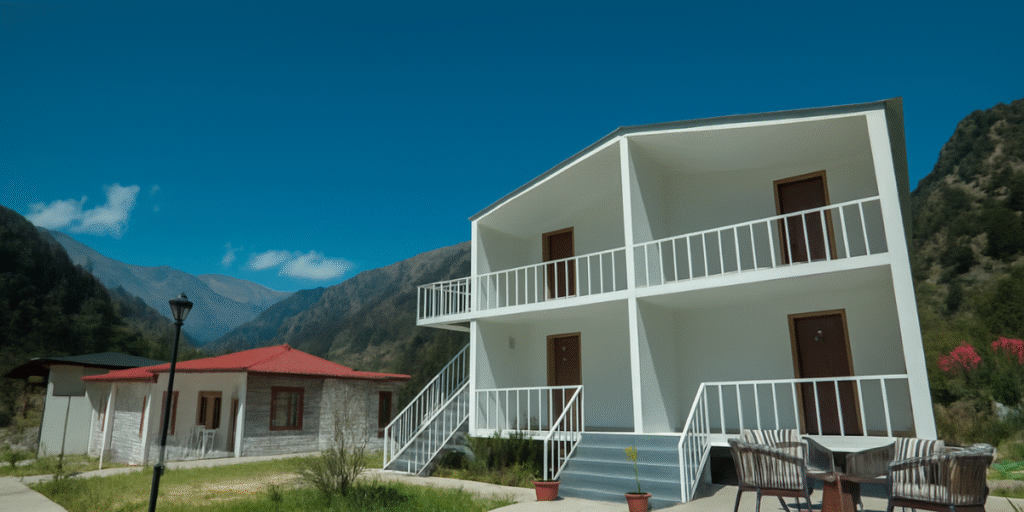
Harsil Valley Hotels
Harsil does not have big hotels or luxury chains, but you’ll find simple and clean places to stay. Most hotels are basic guesthouses, eco-lodges, or government-run rest houses. They offer hot water, warm blankets, and meals on request. Some are riverside while others are closer to the forest. Popular names include Harsil Village Resort, Harsil Retreat, Snowpod Harsil and Prakriti Retreat. Rooms may be limited during peak season, so it’s better to book early. Wi-Fi and mobile signal can be weak, but you’ll enjoy the peace instead.
• Best stays: Harsil Village Resort, Harsil Retreat
• Room cost: ₹4500–₹8500 per night (approx.)
• Meals: Simple veg food, mostly in-house
• Facilities: Hot water, warm bedding, basic comforts
• Booking tip: Reserve early for May–June and Sept–Oct
Harsil Valley From Dehradun
Harsil is about 235 km from Dehradun and takes nearly 7-8 hours to reach by road. The route is long but scenic, passing through Mussoorie, Barkot, and Uttarkashi. After Uttarkashi, the road gets narrow but offers stunning mountain and river views. There are no direct buses, so most people hire a cab or take a shared jeep from Uttarkashi. It’s a safe route in dry months but should be avoided during heavy rains.
- Total distance: ~235 km from Dehradun
- Travel time: 7-8 hours
- Route: Dehradun → Mussoorie → Barkot → Uttarkashi → Harsil
- No direct bus: Take shared jeep from Uttarkashi
- Tip: Start early to reach before sunset
Harsil Valley Photos
Harsil is a dream location for nature photography. Every season gives a different look to the valley. In summer, you get green trees and clear skies. Autumn brings golden orchards and crisp air. In winter, snow covers everything—making it perfect for postcard-style photos. The wooden houses and river bends make excellent frames. Even with a basic phone camera, your pictures will come out well. For best shots, wake up early and explore by foot.
Check Out : 5 Days Harsil Village Tour
Harsil Valley Height
Harsil is located at a height of around 2,620 meters (8,595 feet). This moderate altitude gives it cool air and beautiful views without extreme altitude sickness. Most people can handle this height without much trouble, but it’s still good to rest after reaching. The high altitude also makes the stars look brighter at night and the air feel very fresh. It’s a good stop before heading to Gangotri, which is even higher.
Harsil Valley Distance
Harsil is far from the main cities, which is why it feels so peaceful. From Delhi, the drive is about 470 km and takes nearly 12–13 hours. From Dehradun, it’s around 235 km. The closest town is Uttarkashi, 75 km away. Gangotri is just 25 km ahead. The roads are narrow but paved. Most travelers stop in Uttarkashi for food and fuel before continuing. If you want a relaxed journey, plan stopovers along the way.
- Delhi to Harsil: ~470 km
- Dehradun to Harsil: ~235 km
- Uttarkashi to Harsil: 75 km
- Gangotri to Harsil: 25 km
How Many Days Are Enough for Harsil?
A stay of 3 to 4 days is perfect to explore Harsil Valley at a relaxed pace. Since the area is calm and less commercial, you don’t need a packed itinerary. One day is good for exploring the main village and riverside, another for nearby spots like Dharali, Mukhba, and Gangnani, and a third day for a short hike to Lama Top or simply to relax with nature. Harsil is more about soaking in the silence, mountain views, and local culture than ticking off tourist spots
- Day 1: Arrive in Harsil, explore the village and riverside on foot, relax with mountain views.
- Day 2: Visit Dharali, Mukhba village, and take a hot water dip at Gangnani.
- Day 3: Hike to Lama Top or enjoy a quiet forest walk between Harsil and Bagori.
- Day 4 (Optional): Slow morning, local breakfast, relax before departure.
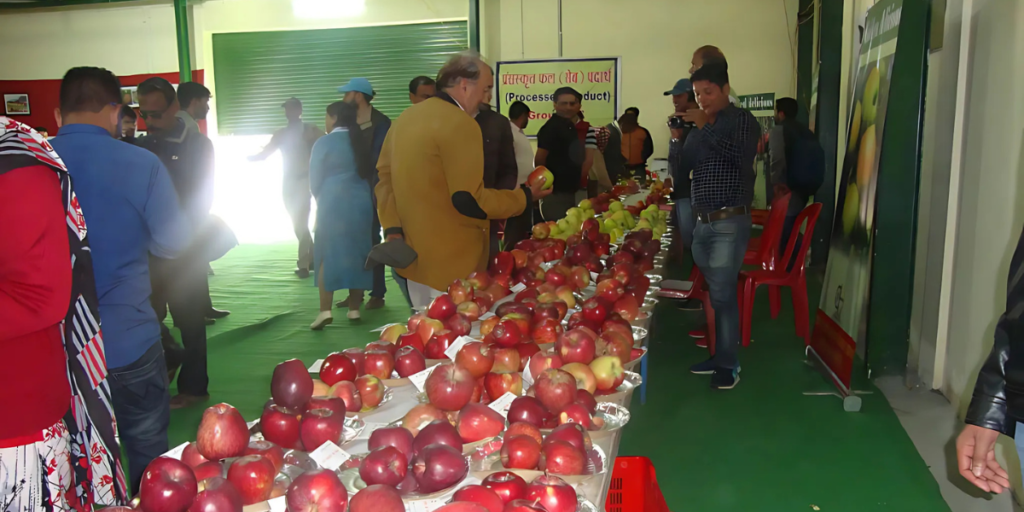
How is the Apple Festival Celebrated in Harsil?
Harsil Apple Festival celebrates the vibrant ruby-red apples of Harsil’s terrace fields. Visitors can enjoy these delicious apples while soaking in the region’s natural beauty, with snow-capped mountains, lush pine forests, and the serene Bhagirathi River as a backdrop.
- It also offers tourists a unique chance to explore the rich cultural heritage of the region.
- Launched in 2018 by DM Ashish Chauhan, the festival aims to promote tourism and boost apple farming in Harsil.
- It serves as a platform for local farmers to showcase their apples, connect with buyers, and expand their market.
- The festival enables farmers to network and directly sell their produce to visitors.
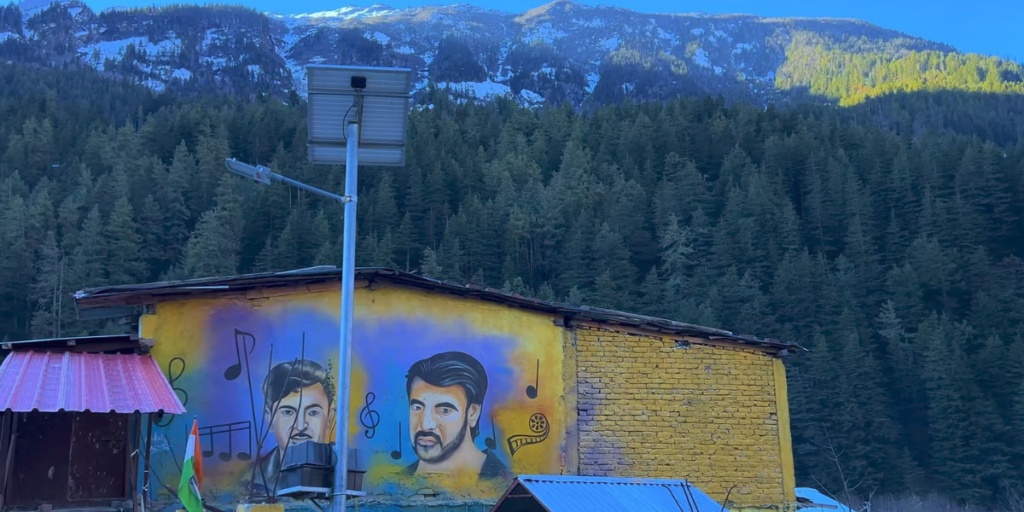
Photography Hotspots in Harsil Valley
Harsil Valley is a dream location for travel photographers who love raw Himalayan landscapes and less-touched locations. With its snow-capped peaks, pine-covered slopes, apple orchards, and the Bhagirathi River cutting through the valley, every turn offers a natural frame. Early mornings are perfect for misty shots over the river, while golden hour adds warmth to the wooden homes and village trails. Winter snow and autumn colors both bring unique vibes. Popular spots include Dharali village, the suspension bridge area, and the riverside trails toward Gangotri road. Don’t forget the night sky—minimal light pollution makes Harsil great for stargazing shots too.
- Bhagirathi River
- Deodar Forests
- Mukhba Village
- Dharali Village
- Tihar & Raithal Village
- Harsil Valley Panorama
Trekking Opportunities Around Harsil Valley
Harsil Valley offers several short and moderate treks that are perfect for beginners and nature lovers. The valley is surrounded by pine forests, rivers, and snow-covered peaks, making even a simple hike feel magical. One of the most popular trails is the Harsil to Dharali walk—an easy, scenic route along the river. For more adventure, the Lama Top trek gives panoramic views of the entire valley and snow peaks. Another highlight is the Mukhba to Gangnani forest trail, ideal during autumn. If you’re planning a base for higher Himalayan treks, Harsil also connects to the Dayara Bugyal and Sat Tal routes via longer trails from nearby villages.
- Gangotri Glacier Trek: A thrilling journey to the source of the Ganges.
- Dayara Bugyal Trek: Easy to moderate trek with stunning alpine meadows.
- Satopanth Tal Trek: A challenging trail with spiritual significance.
- Harsil to Chitkul Trek: A lesser-explored route for seasoned trekkers.
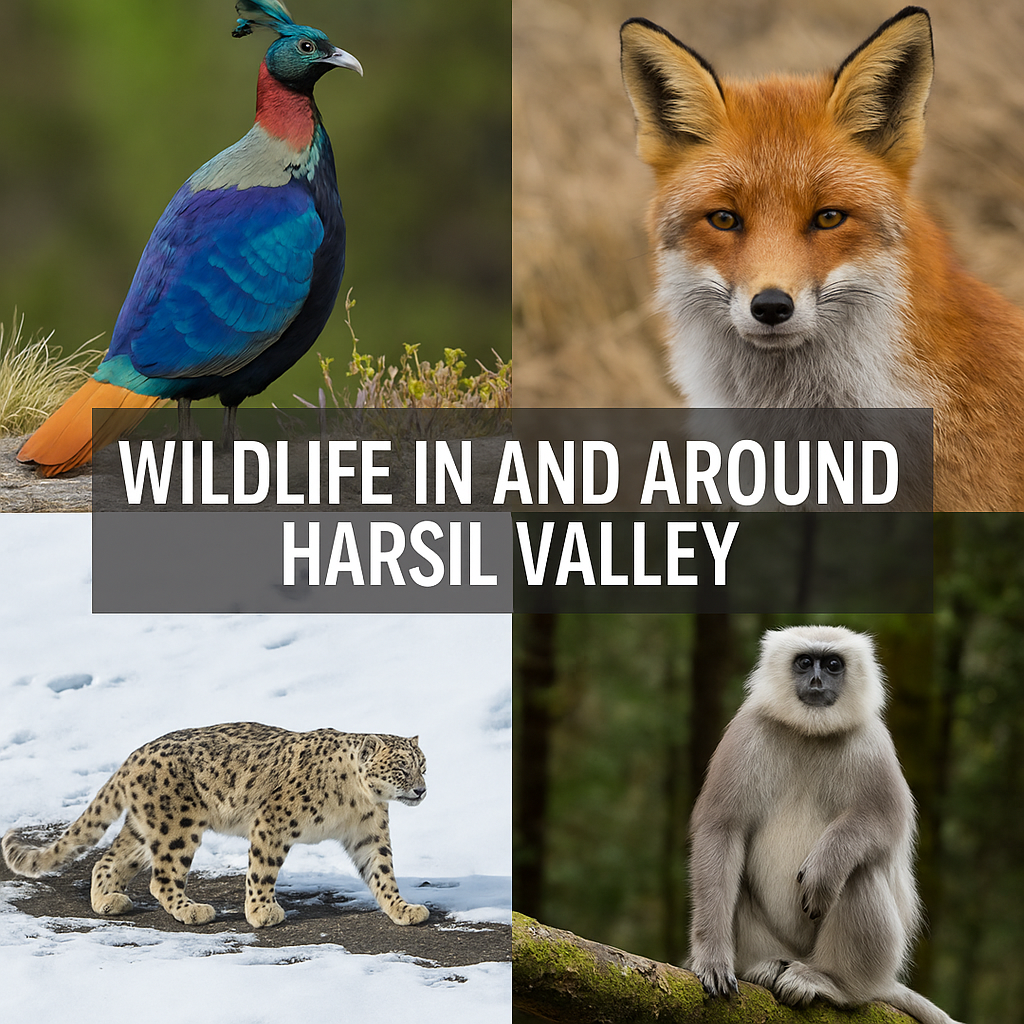
Wildlife in and Around Harsil Valley
Harsil Valley is part of the Gangotri National Park region, making it a peaceful yet rich habitat for Himalayan wildlife. The dense deodar forests, rocky slopes, and alpine meadows create a natural corridor for many species. While sightings are rare due to the quiet nature of these animals, locals and trekkers occasionally report spotting Himalayan monals, barking deer, red foxes, and langurs. If you’re lucky and visiting during colder months, you might even catch a distant glimpse of a snow leopard or footprints in the snow. Birdwatchers can spot eagles, vultures, and various high-altitude finches along the trails. Wildlife here lives quietly, blending with the valley’s stillness—so always carry binoculars and observe respectfully.
- Spot Himalayan species like snow leopards, musk deer, and black bears.
- Visit Gangotri National Park for diverse flora and fauna.
- Enjoy birdwatching with sightings of Himalayan monals and vultures.
- Explore the untouched beauty of forests and hidden wildlife trails.
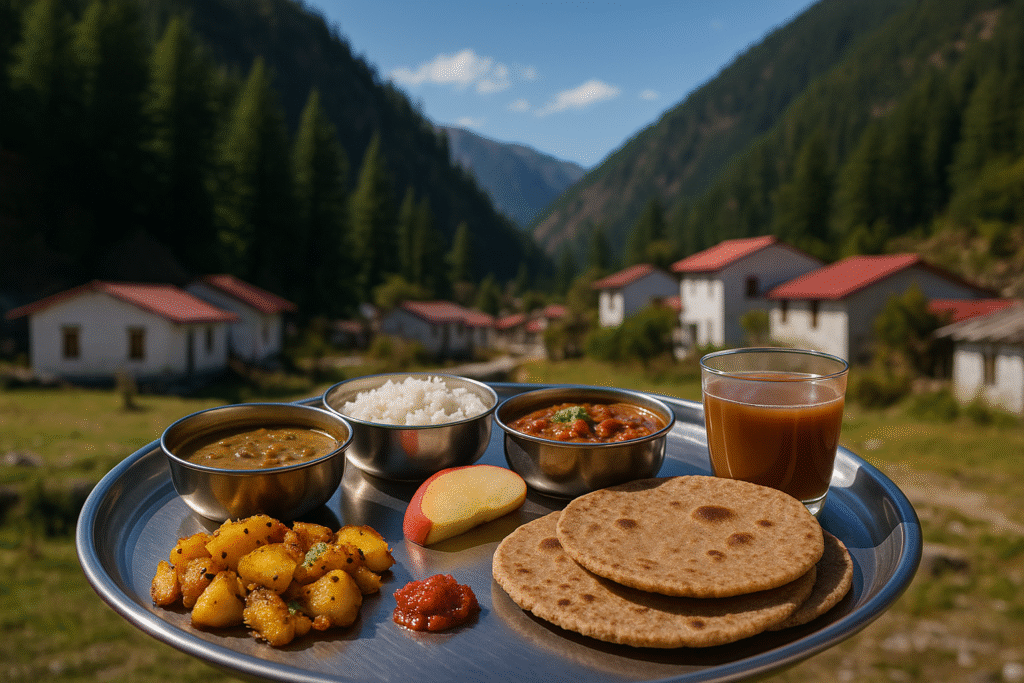
Cuisine of Harsil Valley
Food in Harsil Valley is simple, warm, and rooted in Garhwali tradition. Since it’s a small mountain village, don’t expect fancy restaurants—most meals are home-cooked and served by locals in guesthouses or small dhabas. You’ll find comforting dishes like Aloo ke Gutke, Mandua (ragi) roti, Phaanu (a lentil dish), and Gahat dal, all served with rice or fresh rotis. During apple season, many stays offer fresh apple juice, chutney, or stewed apples. Hot tea and local rajma-chawal are common comfort meals here, especially during cold evenings. The food is less oily, mildly spiced, and perfectly suited for the cold mountain weather.
- What to try: Mandua roti, Gahat dal, Aloo ke Gutke, local rajma
- Fresh add-ons: Seasonal apples, chutneys, village honey
- Where to eat: Homestays, dhabas, Local Hotels
Harsil Valley: An Emerging Eco-Tourism Destination
Harsil Valley is quietly gaining attention as one of Uttarakhand’s most promising eco-tourism spots. Unlike commercial hill stations, Harsil promotes low-impact, slow travel—where nature, culture, and community come first. Visitors stay in local-run homestays or eco-lodges built with native materials and enjoy farm-to-plate meals, forest walks, and village experiences. The valley’s clean air, riverside trails, and limited construction make it ideal for travelers seeking sustainability over luxury. You’ll often find campsites that operate seasonally, organic apple orchards, and locals encouraging plastic-free travel. Birdwatchers, hikers, and photographers love the untouched scenery, while families and solo travelers come here to just slow down.
- Focus on sustainability, local livelihoods, and nature conservation
- Stays: Homestays, eco-lodges, limited campsites
- Activities: Forest hikes, orchard visits, stargazing
- Ideal for: Nature lovers, offbeat travelers, responsible tourists
- Tip: Carry reusable items and respect local customs
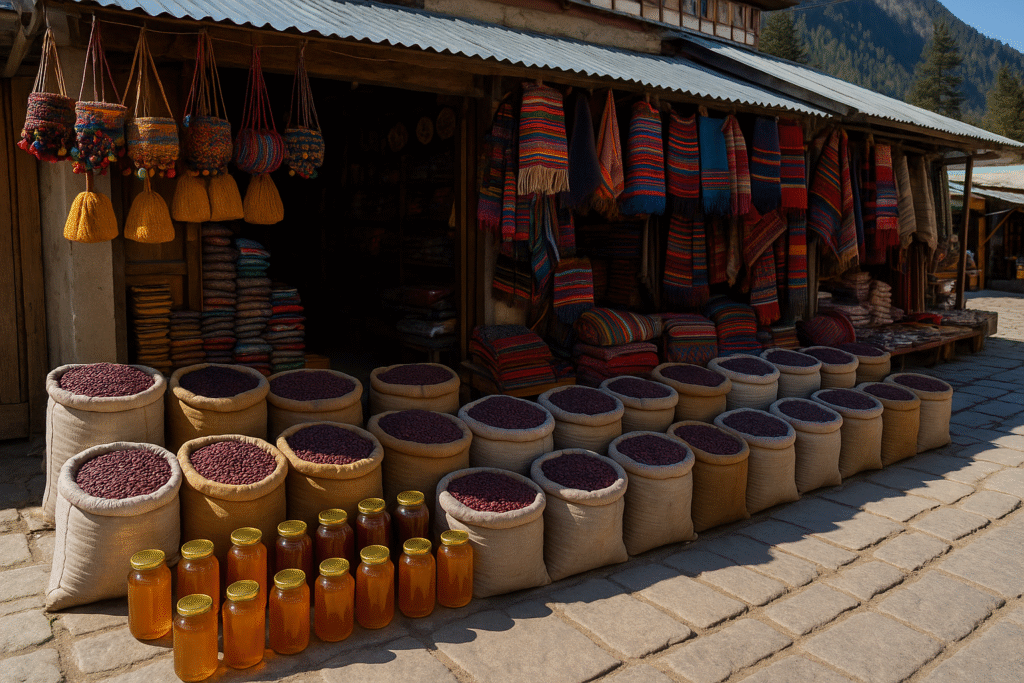
Local Handicrafts and Souvenirs from Harsil Valley
While Harsil isn’t a commercial shopping destination, it offers a few authentic, handmade souvenirs that reflect the culture of the region. You can find locally woven woolen caps, mufflers, and shawls made by women from nearby villages using traditional handlooms. During apple season, many homestays sell homemade apple jam, chutneys, and dried apple rings—a great gift to carry home. Small stalls and homes may also sell herbal teas, organic pulses, rajma (kidney beans), and wild honey sourced from the valley. The best souvenirs here aren’t factory-made—they’re made slowly, by hand, and often come with a story. Prices are modest, and every purchase directly supports the local community.
- Buy woolen shawls and garments made by local artisans.
- Explore wooden artefacts crafted with intricate designs.
- Take home organic products like honey and fruit preserves.
- Shop at local markets for unique and sustainable keepsakes.
About Travel Vaidya – Trusted Travel Experts of Uttarakhand
Travel Vaidya is a Dehradun-based travel company with deep roots across Uttarakhand. For over 9 years, we’ve helped families, senior citizens, and spiritual travelers explore places like Char Dham, Auli, Jim Corbett, Nainital, Kausani, Almora, and Ranikhet with confidence.
We’re not a call center or big-brand OTA—we’re a small team that builds practical, experience-based itineraries. Every plan is shaped by local knowledge, seasonal awareness, and what actually works on-ground.
From temple visits to hotel check-ins, we handle logistics, route planning, and day-wise support—especially for elders and family travelers. We share what we know from living here, not from reading about it.
This guide is part of our effort to make travel in Uttarakhand easier to understand and plan.


